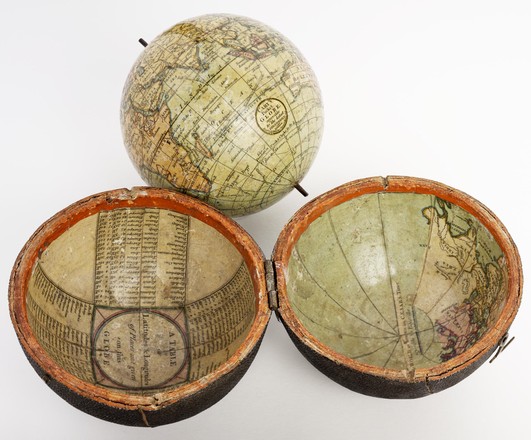A novelty fashion item
Pocket globes were probably
produced both as a novelty fashion items and as educational tools for children.
Most date from the late seventeenth century to the mid nineteenth century and
were particularly popular amongst the English aristocracy. Their small size
(usually around 7.5 cm or 3 inches in diameter) made them impractical for
serious study, but their portability and ease of handling made them perfect for
both the well-educated gentleman and the upper class schoolroom.
What is a globe?
By Joseph Moxon, 'A tutor to astronomie and geographie, or, An easie and speedy way to know the use of both the globes', 1659
‘A Globe (according to the
Mathematical Definition) is a perfect and exact round Body, contained under one
Surface. Of this Form (as hath been proved) consists the Heavens and the Earth:
And therefore the Ancients with much Pains, Study and Industry, endeavouring to
imitate as well the imaginary as the real appearances of them both, have
Invented two Globes: the one to represent the Heavens, with all the
Constellations, fixed stars, Circles and Lines proper thereunto, which Globe is
called the Celestial Globe and the
other with all the Sea Coast, Havens, Rivers, Lakes, Cities, Towns, Hills,
Capes, Seas, Sands, &c. as also the Rumbs, Meridians, Parallels, and other
Lines that serve to facilitate the Demonstration of all manner of Questions to
be performed upon the same: And this Globe is called the Terrestrial Globe.’
Why a pocket globe?
By Whipple Museum of the History of Science, University of Cambridge, 2009
Pocket
globes consist of a terrestrial sphere inside an outer case that often bears
celestial cartography. It is unlikely that pocket globes served precise
practical ends as their size makes accurate calculations impossible and they
tend to lack the rings and dials required for the most common manipulations. It
has been suggested that children could suspend a pocket globe near a candle,
representing the sun, to demonstrate the passing of day into night. This would indicate
that children were the prominent audience for pocket globes.



 Back to list
Back to list